Shaped-Beam Reflectarray Design by Means of Social Network Optimization (SNO)
Abstract
1. Introduction
2. Social Network Optimization
3. Shaped-Beam Reflectarray Design
4. Validation of the SNO-Based Procedure
4.1. Comparison with Other EAs
4.2. Numerical and Experimental Results
5. Conclusions
Author Contributions
Funding
Acknowledgments
Conflicts of Interest
References
- Simon, D. Evolutionary Optimization Algorithms; John Wiley & Sons: Hoboken, NJ, USA, 2013. [Google Scholar]
- Johnson, J.M.; Rahmat-Samii, V. Genetic algorithms in engineering electromagnetics. IEEE Antennas Propag. Mag. 1997, 39, 7–21. [Google Scholar] [CrossRef]
- Robinson, J.; Rahmat-Samii, Y. Particle swarm optimization in electromagnetics. IEEE Trans. Antennas Propag. 2004, 52, 397–407. [Google Scholar] [CrossRef]
- Jia, X.; Lu, G. Hybrid Taguchi Binary Particle Swarm Optimization for Antenna Designs. IEEE Trans. Antennas Propag. 2003, 7, 1662–1664. [Google Scholar] [CrossRef]
- Montgomery, J. Scattering by an Infinite Periodic Array of Microstrip Elements. IEEE Trans. Antennas Propag. 1978, 26, 850–854. [Google Scholar] [CrossRef]
- Huang, J.; Encinar, J.A. Reflectarray Antennas; John Wiley & Sons: Hoboken, NJ, USA, 2013. [Google Scholar]
- Nayeri, P.; Yang, F.; Elsherbeni, A.Z. Reflectarray Antennas: Theory, Designs and Applications; Wiley Online Library: Hoboken, NJ, USA, 2018. [Google Scholar]
- Robinson, J.; Rahmat-Samii, Y. X/Ku Dual-Band Single-Layer Reflectarray Antenna. IEEE Antennas Wirel. Propag. Lett. 2019, 18, 338–342. [Google Scholar]
- Encinar, J.A.; Zornoza, J.A. Broadband Design of Three-Layer Printed Reflectarrays. IEEE Trans. Antennas Propag. 2003, 7, 1662–1664. [Google Scholar] [CrossRef]
- Vita, P.D.; Freni, A.; Dassano, G.; Pirinoli, P.; Zich, R. Broadband Element for High-Gain Single-Layer Printed Reflectarray Antenna. Electron. Lett. 2007, 43, 1247–1249. [Google Scholar] [CrossRef]
- Artiga, X. Row-Column Beam Steering Control of Reflectarray Antennas: Benefits and Drawbacks. IEEE Antennas Wirel. Propag. Lett. 2017, 17, 271–274. [Google Scholar] [CrossRef]
- Yang, H.; Yang, F.; Xu, S.; Li, M.; Cao, X.; Gao, J.; Zheng, Y. A Study of Phase Quantization Effects for Reconfigurable Reflectarray Antennas. IEEE Antennas Wirel. Propag. Lett. 2016, 16, 302–305. [Google Scholar] [CrossRef]
- Ohsawa, T.; Maruyama, T.; Omiya, M.; Suematsu, N. Design of Dual-frequency Reflectarray Using Particle Swam Optimization. In Proceedings of the 2018 International Symposium on Antennas and Propagation (ISAP), Busan, Korea, 23–26 October 2018; pp. 1–2. [Google Scholar]
- Sakagawa, K.; Inoue, H.; Higashi, D.; Deguchi, H.; Tsuji, M. Design of a Dual-Band Single Layer Reflectarray with Arbitrarily-Shaped Elements. In Proceedings of the 2020 IEEE International Symposium on Antennas and Propagation and North American Radio Science Meeting, Montreal, QC, Canada, 5–10 July 2020; pp. 93–94. [Google Scholar]
- Li, C.; Xu, S.; Yang, F.; Li, M. Design and Optimization of a Mechanically Reconfigurable Reflectarray Antenna with Pixel Patch Elements Using Genetic Algorithm. In Proceedings of the 2019 IEEE MTT-S International Wireless Symposium (IWS), Guangzhou, China, 19–22 May 2019; pp. 1–3. [Google Scholar]
- Sheikh, S.; Kishk, A. Multifocal Reflectarray with Optimized Aperture Phase. In Proceedings of the 2020 IEEE International Symposium on Antennas and Propagation and North American Radio Science Meeting, Montreal, QC, Canada, 5–10 July 2020; pp. 137–138. [Google Scholar]
- Geaney, C.; Sun, J.; Hum, S.V.; Rogers, E.S.; Martinez-de-Rioja, E.; Encinar, J.A. Synthesis of a multi-beam dual reflectarray antenna using genetic algorithms. In Proceedings of the 2017 IEEE International Symposium on Antennas and Propagation & USNC/URSI National Radio Science Meeting, San Diego, CA, USA, 9–14 July 2017; pp. 1179–1180. [Google Scholar]
- Meng, X.; Nekovee, M.; Wu, D. Reconfigurable liquid crystal reflectarray metasurface for THz communications. In Proceedings of the Antennas and Propagation Conference 2019 (APC-2019), Birmingham, UK, 11–12 November 2019; pp. 1–6. [Google Scholar]
- Dieter, S.; Fischer, C.; Menzel, W. Design of a folded reflectarray antenna using Particle Swarm Optimization. In Proceedings of the 40th European Microwave Conference, Paris, France, 28–30 September 2010; pp. 731–734. [Google Scholar]
- Pirinoli, P.; Beccaria, M.; Massaccesi, A. MQC10-BBO Optimization Applied to Multi-beam Antenna Design. In Proceedings of the 2019 13th European Conference on Antennas and Propagation (EuCAP), Krakow, Poland, 31 March–5 April 2019; pp. 1–3. [Google Scholar]
- Simon, D. Biogeography-Based Optimization. IEEE Trans. Evol. Comp. 2009, 12, 702–713. [Google Scholar] [CrossRef]
- Chang, D.; Huang, M. Feasibility Study of Erecting Cosecant Pattern by Planar Microstrip Reflectarray Antenna. Proc. AMPC 1993, 2, 19–20. [Google Scholar]
- Pozar, D.; Targonski, S.; Pokuls, R. A Shaped-Beam Microstrip Patch Reflectarray. IEEE Trans. Antennas Propag. 1999, 47, 1167–1173. [Google Scholar] [CrossRef]
- Zhao, G.; Jiao, Y.C.; Chen, G.T. Optimal Design of a Large Dual-Polarization Microstrip Reflectarray with China-Coverage Patterns for Satellite Communications. Front. Inf. Technol. Electron. Eng. 2020, 21, 159–173. [Google Scholar] [CrossRef]
- Carrasco, E.; Barba, M.; Encinar, J.A.; Arrebola, M.; Rossi, F.; Freni, A. Design, Manufacture and Test of a Low-Cost Shaped-Beam Reflectarray using a Single Layer of Varying-Sized Printed Dipoles. IEEE Trans. Antennas Propag. 2013, 61, 3077–3085. [Google Scholar] [CrossRef]
- Prado, D.R.; Lopez-Fernandez, J.A.; Arrebola, M.; Pino, M.R.; Goussetis, G. Wideband Shaped-Beam Reflectarray Design Using Support Vector Regression Analysis. IEEE Antennas Wirel. Propag. Lett. 2019, 18, 2287–2291. [Google Scholar] [CrossRef]
- Salucci, M.; Gelmini, A.; Oliveri, G.; Anselmi, N.; Massa, A. Synthesis of Shaped Beam Reflectarrays with Constrained Geometry by exploiting Nonradiating Surface Currents. IEEE Trans. Antennas Propag. 2018, 66, 5805–5817. [Google Scholar] [CrossRef]
- Grimaccia, F.; Gruosso, G.; Mussetta, M.; Niccolai, A.; Zich, R.E. Design of Tubular Permanent Magnet Generators for Vehicle Energy Harvesting by Means of Social Network Optimization. IEEE Trans. Ind. Electron. 2017, 65, 1884–1892. [Google Scholar] [CrossRef]
- Grimaccia, F.; Mussetta, M.; Niccolai, A.; Pirinoli, P.; Zich, R.E. Recently Developed Social-Based Algorithms for Antennas Optimization. In Proceedings of the 2014 International Conference on Numerical Electromagnetic Modeling and Optimization for RF, Microwave, and Terahertz Applications (NEMO), Pavia, Italy, 14–16 May 2014; pp. 1–4. [Google Scholar]
- Niccolai, A.; Gonano, C.A.; Grimaccia, F.; Mussetta, M.; Zich, R.; Pirinoli, P. Sparse Array Design by Means of Social Network Optimization. In Proceedings of the 2015 IEEE International Symposium on Antennas and Propagation & USNC/URSI National Radio Science Meeting, Vancouver, BC, Canada, 19–24 July 2015; pp. 1336–1337. [Google Scholar]
- Niccolai, A.; Grimaccia, F.; Mussetta, M.; Zich, R.E. Reflectarray optimization by means of SNO and PSO. In Proceedings of the 2016 IEEE International Symposium on Antennas and Propagation (APSURSI), Fajardo, PR, USA, 26 June–1 July 2016; pp. 781–782. [Google Scholar]
- Beccaria, M.; Pirinoli, P.; Niccolai, A.; Zich, R. Application of Social Network Optimization to shaped beam Transmitarray Antennas. In Proceedings of the 2018 IEEE International Symposium on Antennas and Propagation & USNC/URSI National Radio Science Meeting, Boston, MA, USA, 8–13 July 2018; pp. 2203–2204. [Google Scholar]
- Niccolai, A.; Zich, R.; Beccaria, M.; Pirinoli, P. SNO Based Optimization for Shaped Beam Reflectarray Antennas. In Proceedings of the 2019 13th European Conference on Antennas and Propagation (EuCAP), Krakow, Poland, 31 March–5 April 2019; pp. 1–4. [Google Scholar]
- Simon, D. Complex Contagions: A Decade in Review. In Complex Spreading Phenomena in Social Systems; Springer: Berlin/Heidelberg, Germany, 2018; pp. 3–25. [Google Scholar]
- Niccolai, A.; Grimaccia, F.; Mussetta, M.; Zich, R. Modelling of Interaction in Swarm Intelligence Focused on Particle Swarm Optimization and Social Networks Optimization. In Swarm Intelligence—Volume 1: Principles, Current Algorithms and Methods; IET Digital Library: London, UK, 2018. [Google Scholar]
- Grimaccia, F.; Mussetta, M.; Niccolai, A.; Zich, R.E. Optimal Computational Distribution of Social Network Optimization in Wireless Sensor Networks. In Proceedings of the 2018 IEEE Congress on Evolutionary Computation (CEC), Rio de Janeiro, Brazil, 8–13 July 2018; pp. 1–7. [Google Scholar]
- Beccaria, M.; Addamo, G.; Pirinoli, P.; Orefice, M.; Peverini, O.A.; Virone, G.; Manfredi, D.; Calignano, F. Feed system Optimization for Convex Conformal Reflectarray Antennas. In Proceedings of the 2017 IEEE International Symposium on Antennas and Propagation & USNC/URSI National Radio Science Meeting, San Diego, CA, USA, 9–14 July 2017; pp. 1187–1188. [Google Scholar]
- Storn, R.; Price, K. Differential evolution—A simple and efficient heuristic for global optimization over continuous spaces. J. Glob. Optim. 1997, 11, 341–359. [Google Scholar] [CrossRef]
- Khatib, W.; Fleming, P.J. The Stud-GA: A mini revolution? In Proceedings of the International Conference on Parallel Problem Solving from Nature, Amsterdam, The Netherlands, 27–30 September 1998; Springer: Berlin/Heidelberg, Germany, 1998; pp. 683–691. [Google Scholar]
- Available online: http://www.polito.it/lace/ (accessed on 21 March 2021).







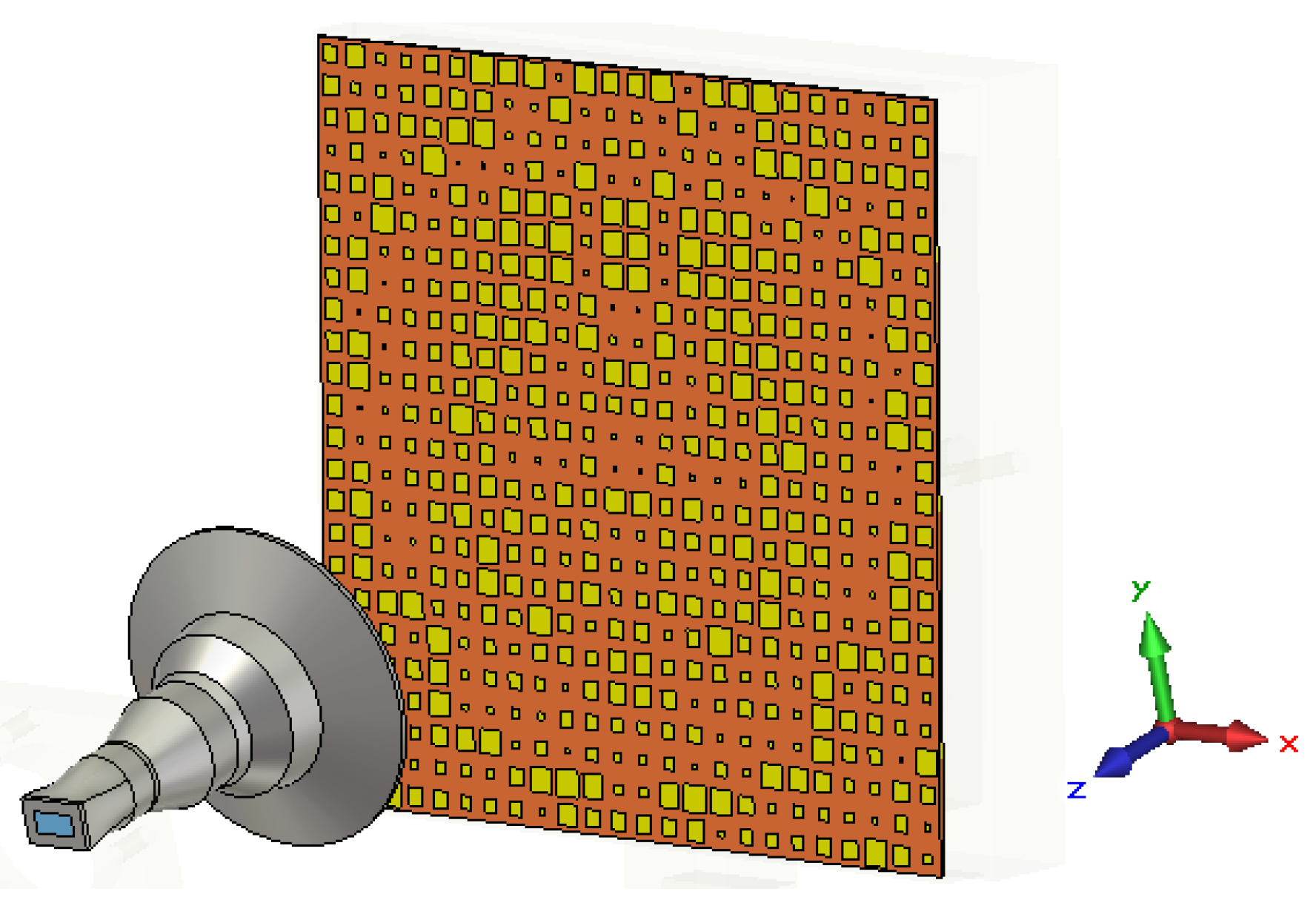
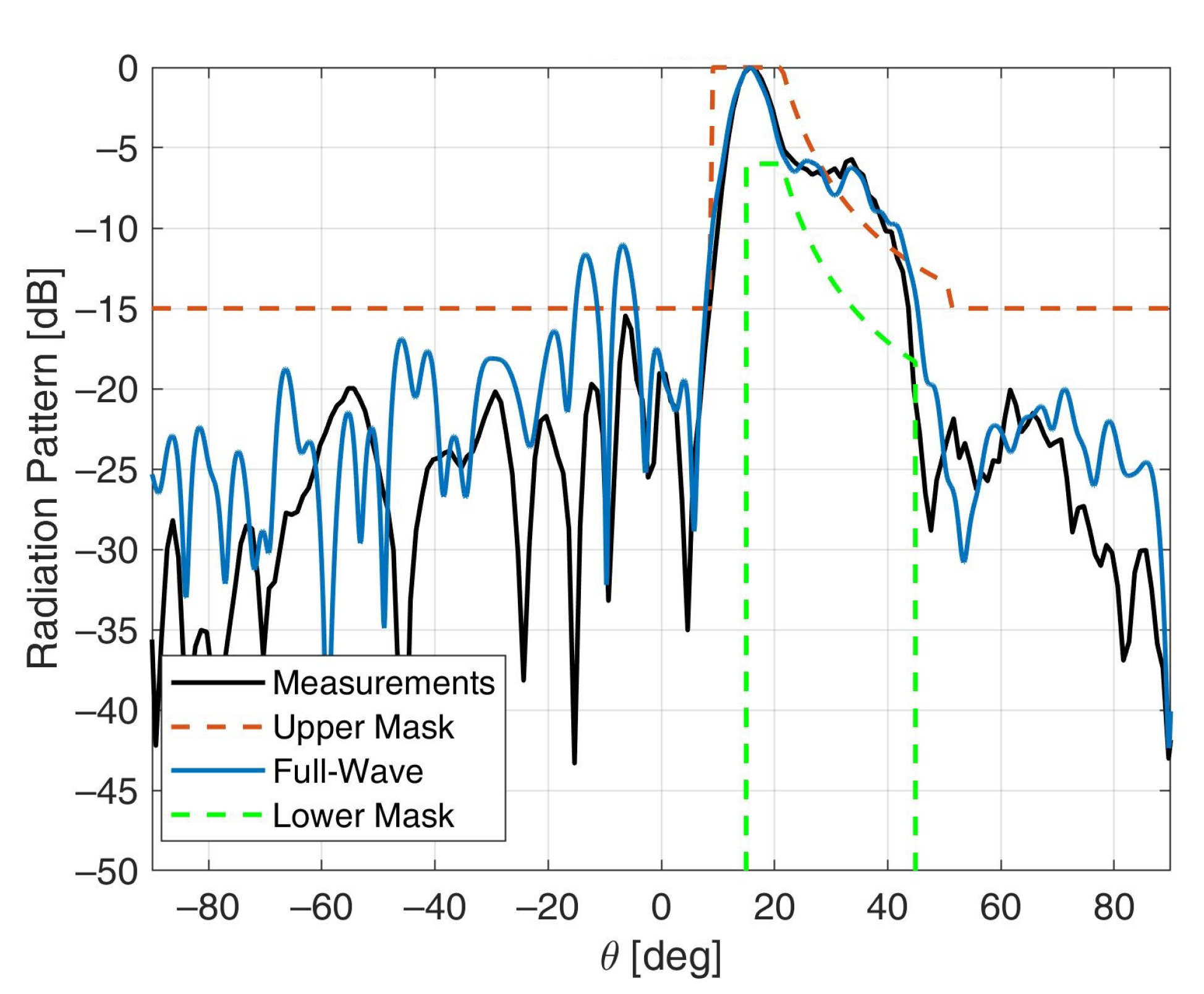

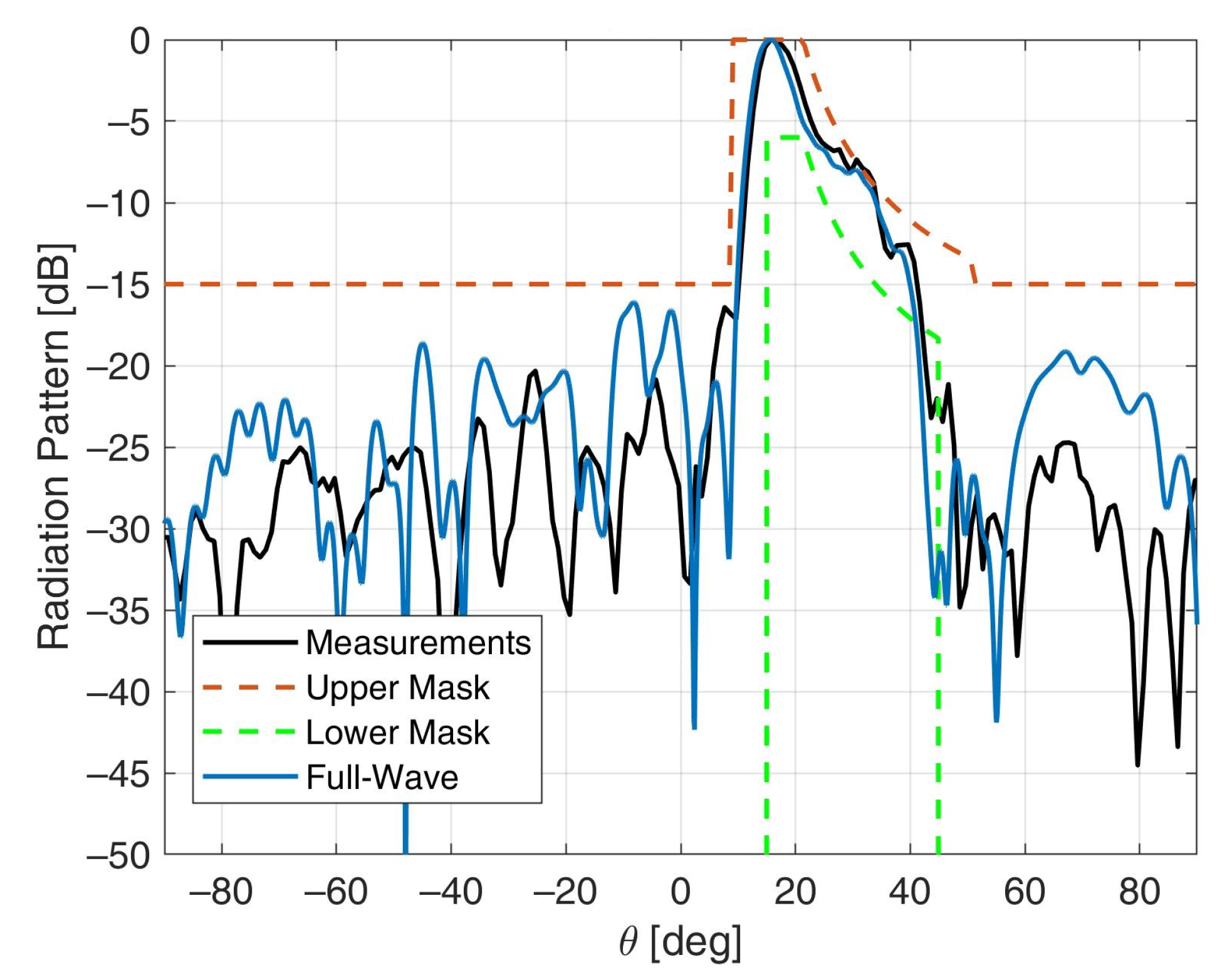
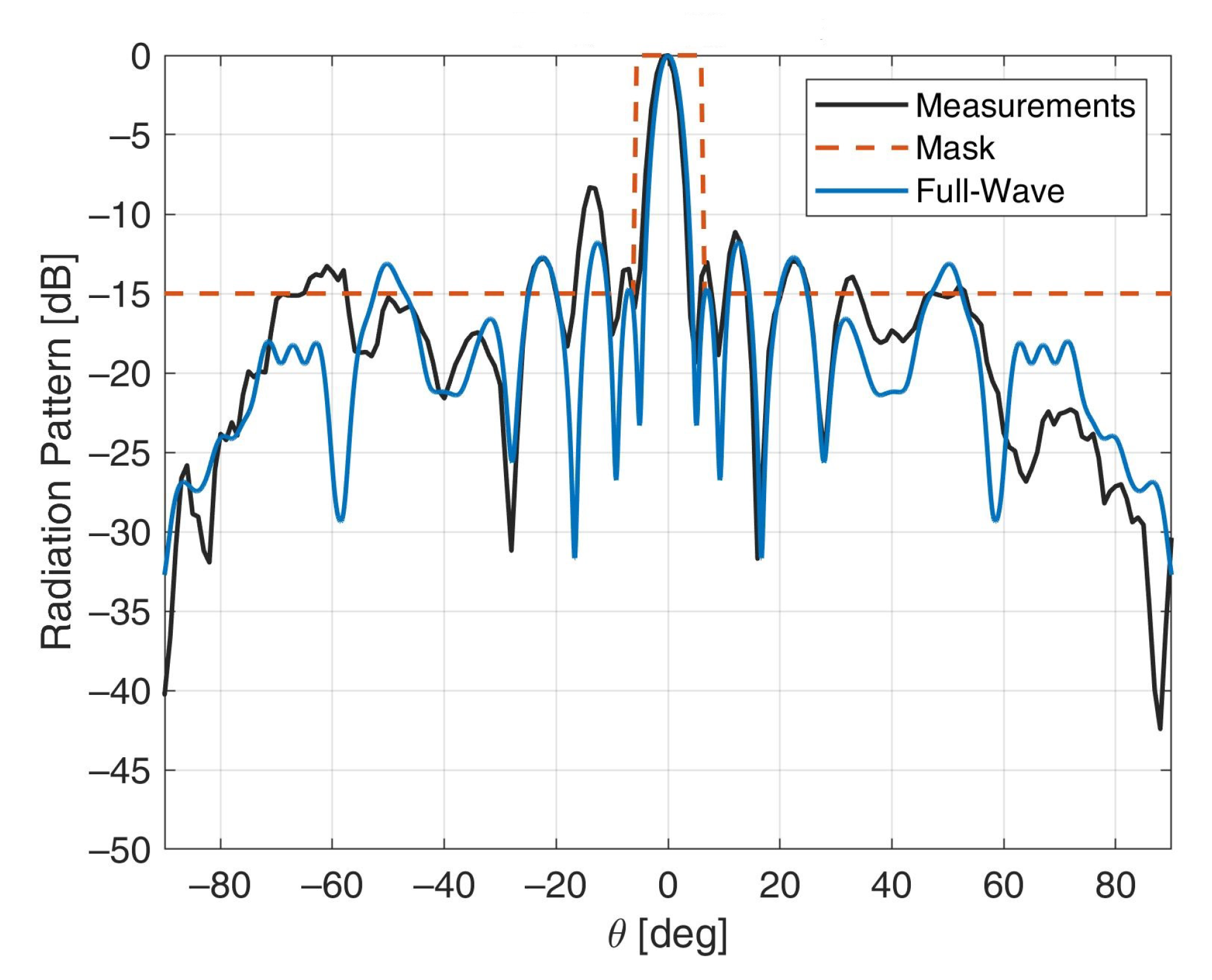
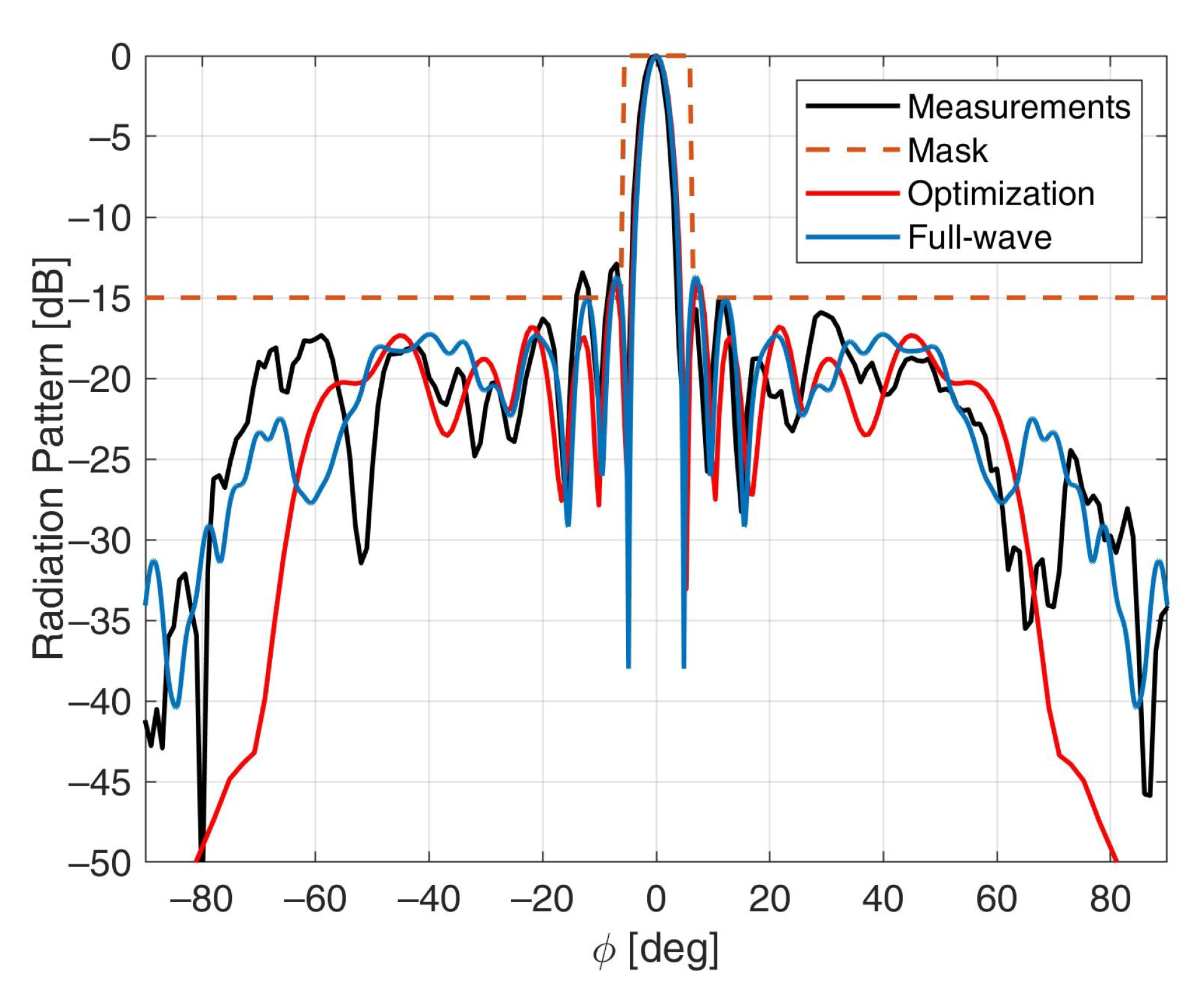
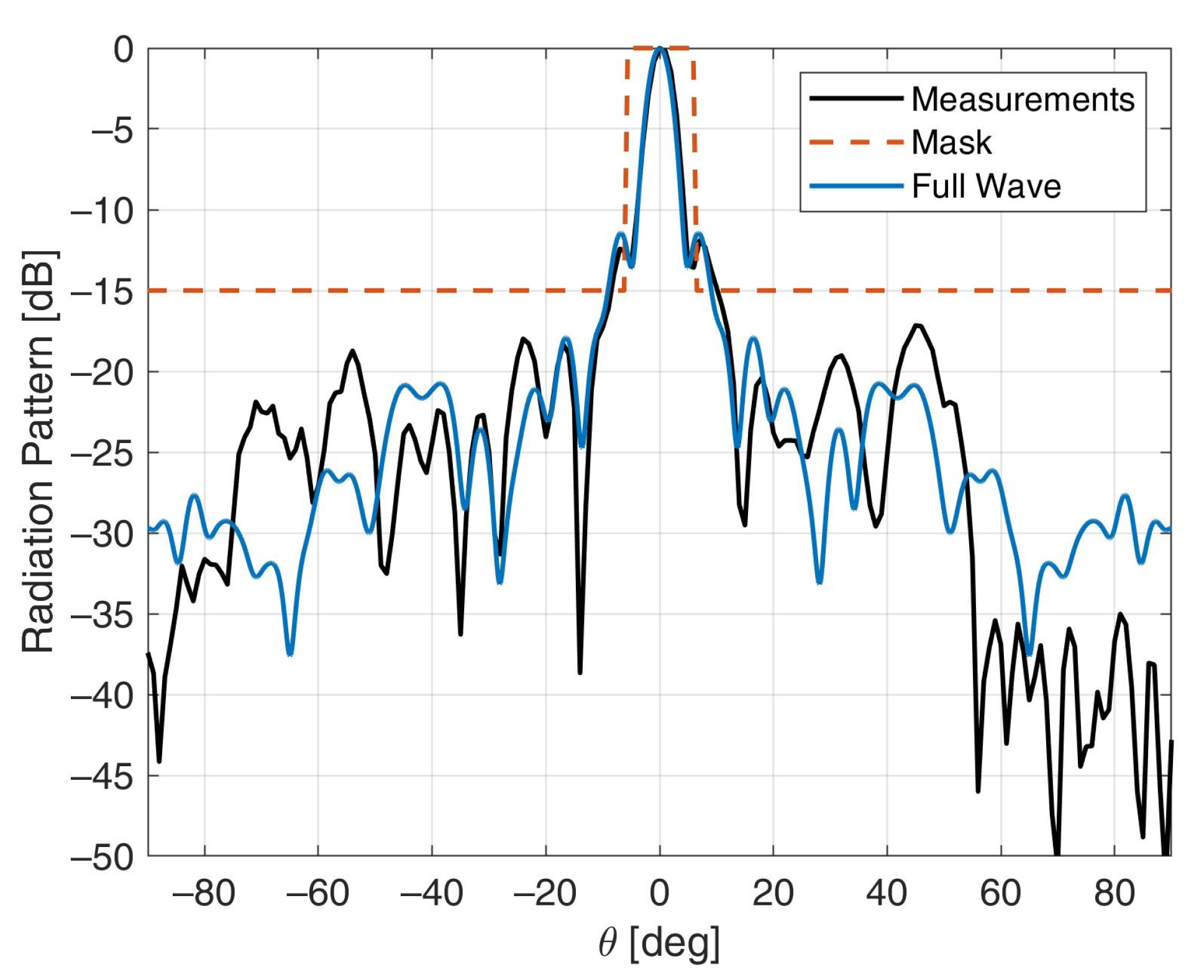


| Algorithm | Mean Value | Standard Deviation |
|---|---|---|
| DE | 9354.38 | 5369.04 |
| GA | 243,774.73 | 485,623.66 |
| MC-BBO | 4554.72 | 4776.57 |
| PSO | 84,245.54 | 119,090.16 |
| SGA | 18,653.25 | 15,363.33 |
| SNO | 1974.42 | 956.48 |
Publisher’s Note: MDPI stays neutral with regard to jurisdictional claims in published maps and institutional affiliations. |
© 2021 by the authors. Licensee MDPI, Basel, Switzerland. This article is an open access article distributed under the terms and conditions of the Creative Commons Attribution (CC BY) license (http://creativecommons.org/licenses/by/4.0/).
Share and Cite
Beccaria, M.; Niccolai, A.; Zich, R.E.; Pirinoli, P. Shaped-Beam Reflectarray Design by Means of Social Network Optimization (SNO). Electronics 2021, 10, 744. https://doi.org/10.3390/electronics10060744
Beccaria M, Niccolai A, Zich RE, Pirinoli P. Shaped-Beam Reflectarray Design by Means of Social Network Optimization (SNO). Electronics. 2021; 10(6):744. https://doi.org/10.3390/electronics10060744
Chicago/Turabian StyleBeccaria, Michele, Alessandro Niccolai, Riccardo E. Zich, and Paola Pirinoli. 2021. "Shaped-Beam Reflectarray Design by Means of Social Network Optimization (SNO)" Electronics 10, no. 6: 744. https://doi.org/10.3390/electronics10060744
APA StyleBeccaria, M., Niccolai, A., Zich, R. E., & Pirinoli, P. (2021). Shaped-Beam Reflectarray Design by Means of Social Network Optimization (SNO). Electronics, 10(6), 744. https://doi.org/10.3390/electronics10060744









